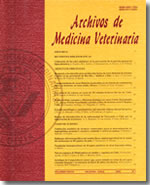Helminths, myxozoans and microsporidians in muscles of commercialised fresh fish and their importance as potential risk for human health in the city of Valdivia, Chile
Main Article Content
Abstract
The prevalence, mean intensity, mean abundance, and mean density of infection by helminths, myxozoans, and microsporidians were determined in the muscles of southern hake, Merluccius australis (n = 104), pink cusk-eel, Genypterus blacodes (n =81), and snoek, Thyrsites atun (n = 95), all of them sold fresh in the city of Valdivia, Chile. Fish were examined on a candling table, with direct observation of the dorsal and ventral muscles (candling 1), in cuts 4 mm thick or less (candling 2), and on a glass plate compression. Prevalence, mean intensity, and mean abundance of infection, by all the identified parasites in each host, were significantly higher (P < 0.05) in hake and pink cusk-eel, compared with the snoek. Mean density of infection in the hake was higher (P < 0.05) than in pink cusk-eel; the latter had a higher (P < 0.05) density of infection than the snoek. All fish hosts showed parasites with potential risks to human health, such as Anisakis sp. types I and II or Pseudoterranova sp. Other parasites were also detected in each fish host: metacercariae of trematodes, Hepatoxylon trichiuri, Pseudoterranova sp., Anisakis sp. type I, Kudoa sp., and microsporidians in the hake; metacercariae of trematodes, Pseudoterranova sp., Anisakis sp. types I and type II, Corynosoma sp., Kudoa sp., and microsporidians in pink cusk-eel; and Molicola sp., Pseudoterranova sp., and Anisakis sp. type I in the snoek.Pseudoterranova sp. and Molicola sp. had the highest prevalence, mean intensity, mean abundance, and mean density of infection in the pink cush-eel and the snoek, respectively. In the hake, the highest prevalence, mean abundance and mean density were determined for Kudoa sp; mean intensity of infection was highest for microsporidiosis.

